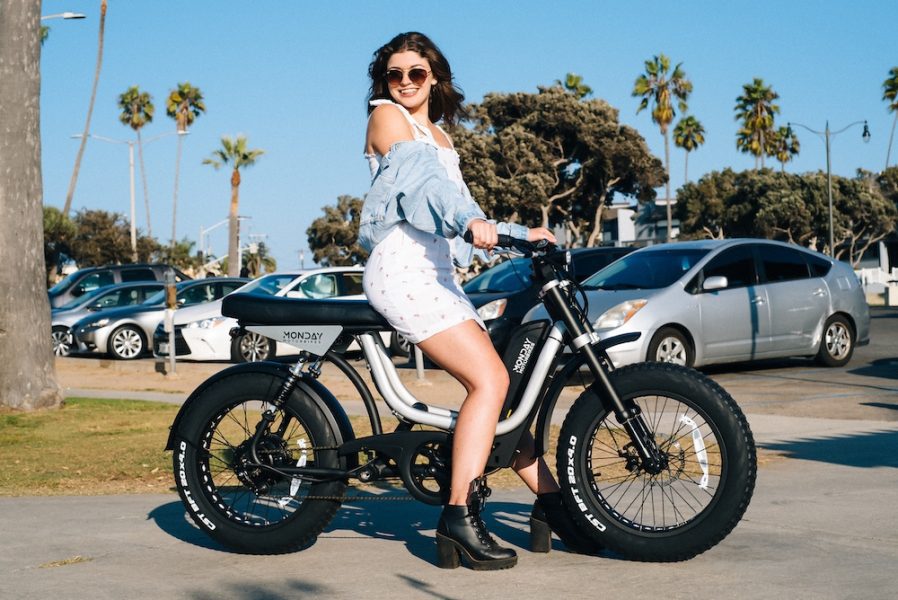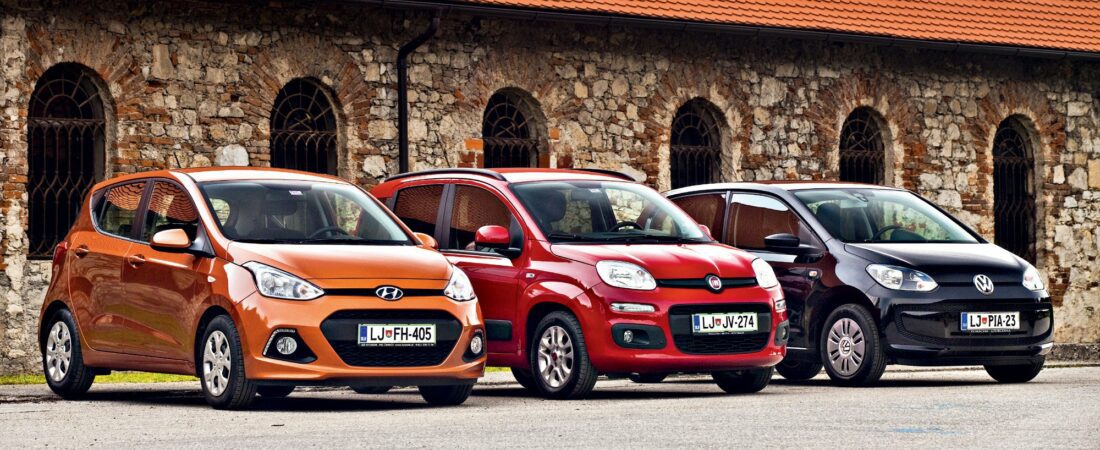
Comparison test: Fiat Panda, Hyundai i10 and VW up
Content
- 3th place
- 2th place
- 1th place
- Volkswagen Move up! 1.0 (55 kW)
- Basic data
- Technical information
- Our measurements
- Basic data
- Technical information
- Our measurements
- Basic data
- Technical information
- Our measurements
- Exterior (12/15)
- Interior (81/140)
- Engine, gearbox (46 / 40)
- Ride quality (49/95)
- Performance (20/35)
- Security (32/45)
- Economy (41/50)
- Exterior (12/15)
- Interior (85/140)
- Engine, gearbox (44 / 40)
- Ride quality (49/95)
- Performance (19/35)
- Security (30/45)
- Economy (41/50)
- Exterior (10/15)
- Interior (72/140)
- Engine, gearbox (38 / 40)
- Ride quality (45/95)
- Performance (16/35)
- Security (25/45)
- Economy (28/50)
- Volkswagen Move up! 1.0 (55 kW)
Volkswagen was the first to decide to make a small but grown-up car. Almost simultaneously with this, Fiat took care of the new generation of Panda. With the release of the i10, Hyundai made a serious statement last year that its contribution to the subcompact class is a serious competitor to the Upu. Since we will be getting two more innovations in this class this autumn, of course one of them is the third generation Twingo from Novo mesto, we thought it was right to see what the upcoming innovations would have to achieve or be even better. V.
All three readers of Auto magazine already know. It is true, however, that we do not find a large selection of engines among cars in this class. Only our Hyundai compared this time had a smaller engine than the one we tested this winter (test in AM 6/2014). At the time, we had the best-equipped i10 with a large 1,2-liter four-cylinder and rich Style equipment. This time, with two slightly older models from the Fiat and Volkswagen family, the i10 competed with a three-cylinder one-liter engine and slightly less rich equipment.
Once upon a time, Fiat was a great brand among European car brands, offering small cars. It's also the only one that offers two options besides the Panda, another 500. But it only has two doors, so it didn't pass our test. Even though the 500 is already a bit older, it could still be in the game. Panda is a car more focused on usability. But it's also true that Fiat didn't put too much effort into making the third generation, so we can conclude that the current Panda is more of an update than a completely redesigned design. The Volkswagen Up has been a good traveler since birth - in many ways the VW was inspired by the Fiat 500 and created a much more serious car than we're used to with Europe's biggest brand. However, the Up is also the only one where you only get one engine (with a negligible proportion of those opting for the less powerful version).
The longest of the three tested is Hyundai, Panda is a little less than two centimeters shorter, Up is the shortest, and Hyundai VW is 12 cm taller. But the Up has the longest wheelbase, so the wheels are really on the extreme ends of the body. Thus, there is no noticeable undernourishment in terms of area in Volkswagen. In many ways, it feels like when we sit in one or the other, Panda pulls the shortest.
Probably because the driver's workplace is cramped, as the wider center console and legroom extending to the driver's legroom are too limiting for the legs. The impression of the (otherwise limited) rear seat space is very similar in all three, the seats differ only in body position; so in the Panda we are sitting upright, in the Hyundai they are flatter and with a feeling of maximum spaciousness, while in the Upa the body position is perfect, but the worry is that the larger passengers do not have enough space for the top.
Ease of use of the passenger compartment is limited by its size, but here the sensations are different, although the size of the cabins is quite similar. Panda just has an unfinished bench, so it is of course in last place. The I10 and Up are similar in this respect, except that the Up with an intermediate floor has the option of a completely flat floor when the rear seat backs are turned over. Panda is also the only one where we cannot fit child seats on the back bench using the Isofix system.
In the area of engines, Panda lagged behind mainly because of equipment that allows it to operate with lower maintenance costs, such as dual-fuel, gasoline or gas engines. The Panda's engine power rating is pretty solid, but in normal driving it can't be put equally on the sidelines of both competitors. They surprise mostly with ample torque at low revs, where Up is the best option. Thus, when driving in the city, we can drive at lower speeds, which, in the end, can be seen in a lower average consumption.
Handling and driving comfort are usually not on the list of priorities for buyers of such small cars. But for all three cars tested, we can say that they provide quite satisfactory comfort. The Up handles shorter bumps more efficiently thanks to a slightly longer wheelbase (e.g. feel when crossing bumps). The difference in position on the road between all three is very small, so we cannot write about noticeable differences here.
Not so long ago, it was believed that safety devices found in small cars were usually quite rare. But even in this area, manufacturers' perceptions of what is needed as standard equipment in small cars are changing. This, of course, has been largely aided by the raising of criteria in EuroNCAP, which conducts test accidents and awards different ratings depending on the additional devices in the vehicles.
Among the three, the Panda has the least amount of safety equipment as it only has two front airbags and two window airbags as well as basic electronic support (ABS and ESP/ESC) which is mandatory on all vehicles in the European market for some . time. Hyundai also offers a slightly tweaked ESC system, as well as two side-curtain airbags that deploy from the backrest and two window airbags. Volkswagen has a little more than four airbags, two front and two combined side airbags, as well as City Brake, an advanced low-speed collision avoidance system.
Conclusion: In fact, our order of three from the test could have been swapped in at least the first two places if we didn't provide a significant advantage to Volkswagen - a safety system that prevents collisions with the car ahead at low speeds or - at a little higher - effectively reduces the consequences of such a collision. Hyundai has overtaken Volkswagen in terms of usability because it has more equipment. At the chosen level of equipment, the Up (Move) is strangely equipped with a radio that such a modern car does not deserve (and we have already learned better in it), and manual adjustment of the settings of the exterior mirrors and the rear door, which can only be opened by a slot or dislocate the rear part of the glass out.
The personal choice when looking for the most suitable of the leading pair should be based on what we ourselves give priority - more safety or more ease of use and comfort. Unfortunately, compared to our competitors, we were a bit disappointed with Panda. Already because of some less successful decisions or because of a typical Italian inaccuracy. Last but not least, because of the price. The Panda may be the right choice for those looking for an economical small car and driving tens of thousands of miles a year when they justify the higher price with the lower cost of gas fuel.
In any case, there is no real reason why such cars are not popular with Slovenian buyers. In almost all comparative categories, they have already fully approached or even overtaken the representatives of the upper class.
3th place
Fiat Panda 1.2 8v LPG interior
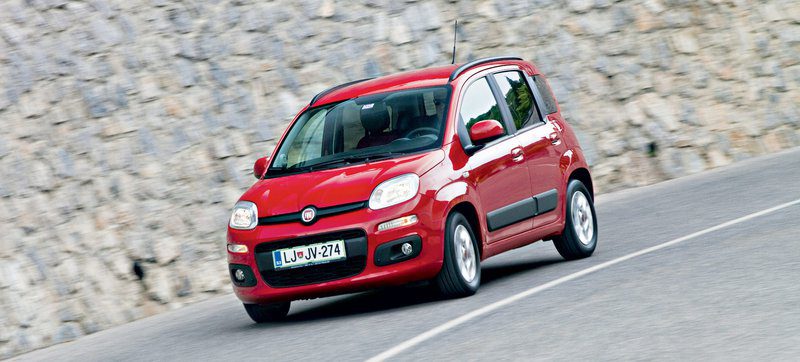
2th place
Hyundai i10 1.0 (48 kW) Comfort
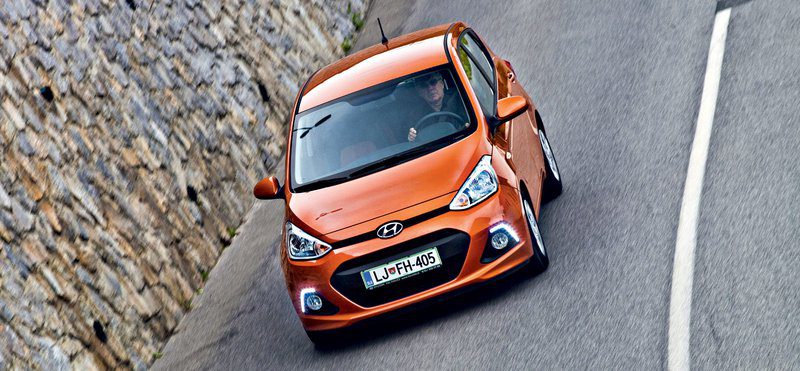
1th place
Volkswagen Move up! 1.0 (55 kW)
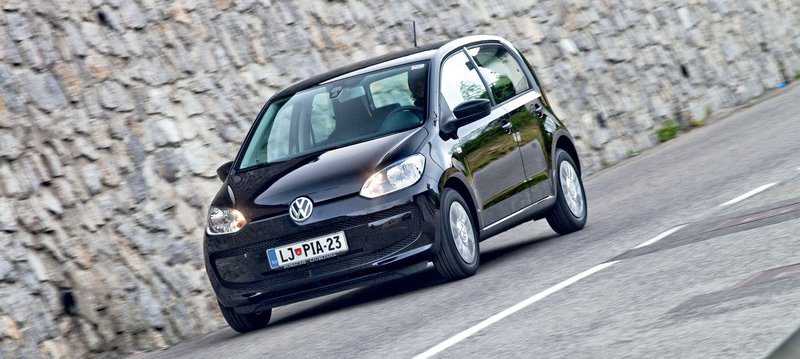
Text: Tomaž Porekar
Volkswagen Move up! 1.0 (55 kW)
Basic data
| Sales: | Porsche Slovenia |
|---|---|
| Base model price: | 8.725 € |
| Test model cost: | 10.860 € |
| Calculate the cost of auto insurance | |
| Acceleration (0-100 km / h): | 16,2 with |
| Maximum speed: | 171 km / h |
| Mixed flow ECE: | 4,7l / 100km |
Technical information
| engine: | 3-cylinder - 4-stroke - in-line - petrol - displacement 999 cm3 - maximum power 55 kW (75 hp) at 6.200 rpm - maximum torque 95 Nm at 3.000-4.300 rpm. |
|---|---|
| Energy transfer: | front wheel drive engine - 5-speed manual transmission - tires 165/70 R 14 T (Hankook Kinergy Eco). |
| Capacity: | 171 km/h top speed - 0-100 km/h acceleration in 13,2 s - fuel consumption (ECE) 5,9/4,0/4,7 l/100 km, CO2 emissions 107 g/km. |
| Mass: | empty vehicle 929 kg - permissible gross weight 1.290 kg. |
| External dimensions: | length 3.540 mm – width 1.641 mm – height 1.489 mm – wheelbase 2.420 mm – trunk 251–951 35 l – fuel tank XNUMX l. |
Our measurements
| T = 19 ° C / p = 1.010 mbar / rel. vl. = 58% / odometer status: 1.730 km | |
| Acceleration 0-100km: | 16,2s |
|---|---|
| 402m from the city: | 20,4 years ( 112 km / h) |
| Flexibility 50-90km / h: | 18,1s (IV.) |
| Flexibility 80-120km / h: | 36,0s (V.) |
| Maximum speed: | 171km / h (V.) |
| Fuel consumption according to the standard scheme: | 4,3 l / 100km |
| Braking distance at 100 km / h: | 41,0m |
| AM table: | 40m |
| Noise at 50 km / h in 4rd gear | 63dB |
| Noise at 90 km / h in 4rd gear | 66dB |
| Noise at 130 km / h in 4rd gear | 70dB |
Hyundai i10 1.0 (48 kW) Comfort
Basic data
| Sales: | Hyundai Auto Trade Ltd. |
|---|---|
| Base model price: | 8.990 € |
| Test model cost: | 10.410 € |
| Calculate the cost of auto insurance | |
| Acceleration (0-100 km / h): | 16,3 with |
| Maximum speed: | 155 km / h |
| Mixed flow ECE: | 4,7l / 100km |
Technical information
| engine: | 3-cylinder - 4-stroke - in-line - petrol - displacement 998 cm3 - maximum power 48 kW (66 hp) at 5.500 rpm - maximum torque 95 Nm at 3.500 rpm. |
|---|---|
| Energy transfer: | front wheel drive engine - 5-speed manual transmission - tires 175/65 R 14 T (Continental ContiEcoContact 5). |
| Capacity: | 155 km/h top speed - 0-100 km/h acceleration in 14,9 s - fuel consumption (ECE) 6,0/4,0/4,7 l/100 km, CO2 emissions 108 g/km. |
| Mass: | empty vehicle 1.008 kg - permissible gross weight 1.420 kg. |
| External dimensions: | length 3.665 mm – width 1.660 mm – height 1.500 mm – wheelbase 2.385 mm – trunk 252–1.046 40 l – fuel tank XNUMX l. |
Our measurements
| T = 19 ° C / p = 1.012 mbar / rel. vl. = 60% / odometer status: 5.906 km | |
| Acceleration 0-100km: | 16,3s |
|---|---|
| 402m from the city: | 20,0 years ( 110 km / h) |
| Flexibility 50-90km / h: | 18,9s (IV.) |
| Flexibility 80-120km / h: | 22,2s (V.) |
| Maximum speed: | 155km / h (V.) |
| Braking distance at 100 km / h: | 45,2m |
| AM table: | 40m |
| Noise at 50 km / h in 4rd gear | 62dB |
| Noise at 90 km / h in 4rd gear | 65dB |
| Noise at 130 km / h in 4rd gear | 69dB |
Fiat Panda 1.2 8v LPG interior
Basic data
| Sales: | Avto Triglav doo |
|---|---|
| Base model price: | 8.150 € |
| Test model cost: | 13.460 € |
| Calculate the cost of auto insurance | |
| Acceleration (0-100 km / h): | 16,9 with |
| Maximum speed: | 164 km / h |
| Mixed flow ECE: | 5,2l / 100km |
Technical information
| engine: | 4-cylinder - 4-stroke - in-line - petrol - displacement 1.242 cm3 - maximum power 51 kW (69 hp) at 5.500 rpm - maximum torque 102 Nm at 3.000 rpm. |
|---|---|
| Energy transfer: | front wheel drive engine - 5-speed manual transmission - tires 175/65 R 14 T (Continental ContiEcoContact). |
| Capacity: | 164 km/h top speed - 0-100 km/h acceleration in 14,2 s - fuel consumption (ECE) 6,7/4,3/5,2 l/100 km, CO2 emissions 120 g/km. |
| Mass: | empty vehicle 1.015 kg - permissible gross weight 1.420 kg. |
| External dimensions: | length 3.653 mm – width 1.643 mm – height 1.551 mm – wheelbase 2.300 mm – trunk 225–870 37 l – fuel tank XNUMX l. |
Our measurements
| T = 20 ° C / p = 1.017 mbar / rel. vl. = 57% / odometer status: 29.303 km | |
| Acceleration 0-100km: | 16,9s |
|---|---|
| 402m from the city: | 20,5 years ( 110 km / h) |
| Flexibility 50-90km / h: | 19,3s (IV.) |
| Flexibility 80-120km / h: | 29,3s (V.) |
| Maximum speed: | 164km / h (V.) |
| Fuel consumption according to the standard scheme: | 5,9 l / 100km |
| Braking distance at 100 km / h: | 40,9m |
| AM table: | 40m |
| Noise at 50 km / h in 4rd gear | 60dB |
| Noise at 90 km / h in 4rd gear | 63dB |
| Noise at 130 km / h in 4rd gear | 68dB |
Overall rating (281/420)
Exterior (12/15)
Interior (81/140)
Engine, transmission (46
/ 40)Driving performance (49
/ 95)Performance (20/35)
Security (32/45)
Economy (41/50)
We praise and reproach
most convincing engine
position on the road
excellent noise insulation and driving performance on flat roads
driving position
fuel consumption
pre-flooded radio
manual adjustment of the outside rearview mirrors, out of the reach of the driver
opening the rear windows in the door only in case of dislocations
there are no dumps in the back door
Overall rating (280/420)
Exterior (12/15)
Interior (85/140)
Engine, transmission (44
/ 40)Driving performance (49
/ 95)Performance (19/35)
Security (30/45)
Economy (41/50)
We praise and reproach
rich equipment
solid road position
Transmission
soundproofing
end products
driving position
front seats only middle
flat backs
a small part of the backrest partition on the right
look back
unconvincing rear towards the bumpy road
Overall rating (234/420)
Exterior (10/15)
Interior (72/140)
Engine, transmission (38
/ 40)Driving performance (45
/ 95)Performance (16/35)
Security (25/45)
Economy (28/50)
We praise and reproach
flexibility
adroitness
dual fuel saves many kilometers per year
roof slats
transparency of counters
short landing part of the seats
useless and rare dumps for storing small items in the cabin
flimsy engine
